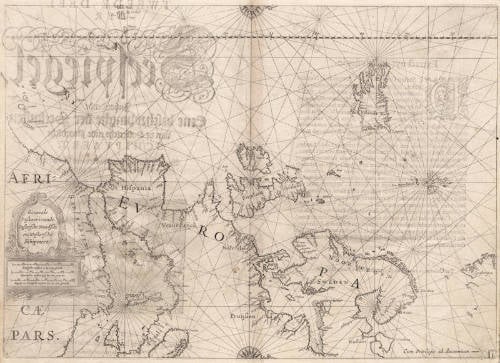Leen Helmink Antique Maps
Old Master Print of the Allegory of Europe - Atlas Maior frontispiece by Joan Blaeu
Stock number: 18842
Zoom ImageCartographer(s)
Joan Blaeu (biography)
Title
Europa
First Published
Amsterdam, 1662
This Edition
1662
Size
44.5 x 30.5 cms
Technique
Condition
excellent
Price
$ 3,250.00
(Convert price to other currencies)
Description
Magnificent Atlas Maior allegorical frontispiece of Europe, depicting the "Rape of Europe" in Greek mythology, with Zeus (Roman name: Jupiter) in the guise of a white bull abducting the virgin Europa.
This particular frontispiece is of exceptional rarity, because it appears in very few copies of Johan Blaeu's Atlas Major.
Stunning colour, heightened in gold.
"Joan Blaeu was the son and successor of the great globe, instrument, and atlas-maker Willem Janszoon Blaeu. After the death of his father in 1638 Joan expanded the family firm's atlas production considerably.
The culmination of their output was the publication of the Atlas Maior (or Grand Atlas) in 1662. In its most complete form the work comprises 11 or 12 parts or volumes and over 600 maps. Earlier atlases from the Blaeu establishment had titlepages centred around an architectural frame. However, for his Grand Atlas, Joan Blaeu broke away from this somewhat formal tradition and introduced a more pictorial composition as a general frontispiece, coupled with a typographic titlepage. There were five further frontispieces for the continental sections: Europe, Africa, America, Asia and Arctica.
Examples of Blaeu's main frontispiece were used for all impressions of his Atlas Maior throughout the 1660s. The continental frontispieces, however, are not found in all editions and thus in some cases they are quite rare.
The frontispiece for Europe depicts the familiar legend of the maiden Europa being abducted from her forlorn companions on shore and taken -perhaps not unwillingly- out to sea by a determined bull. She was not immediately aware that the bull was the god Jupiter who had fallen in love with her but, beguiled by the bull's good nature and his disguise, she climbed onto his back. The bull then bore her out to sea and ravished her; hence the 'Rape of Europa' as described by Ovid in his Metamorphoses 2:836-875.
There is a 1562 painting on this theme by Titian in the Isabella Stewart Gardner Museum in Boston although Titian was not alone in reading Ovid and taking Jupiter's rape for his subject theme. This frontispiece is unsigned but is not unreasonably attributed to Joannes de Visscher by comparison with his other (signed) works."
(Shirley).
"Joan Blaeu had designed and engraved for his Atlas Maior a series of five allegorical title pages: a general one for the atlas as a whole, and four for the continents Arctic, Europe, Africa, and America. For Asia a different title page was used, based on the title page of the Atlas Sinensis.
The design for these plates was probably by Nicolaes van Berchem (1620-1683) and they were engraved by Cornelis van Dalen, Jeremias Falck, and Johannes Visscher.
Except for the general title page, those prints were not used for all atlases.
(van der Krogt).
"Frontispiece Europe for the Atlas Maior
Allegorical representation of Europe. The continent is depicted as Europa, the daughter of the King Agenor of Sidon. When she and here companions were off gathering flowers by the sea, Zeus noticed this charming group, particularly Europa, and appeared to them as a white bull. Europe slid on to the bulls back and the bull charged off, plunging into the sea, and began to swim rapidly from the shore. This scene is depicted here. In the sky three putti with a banderol inscribed “EVROPA.” This plate is engraved by Johannes Visscher.
Occurence: Volume 1 of 1662ff Latin (not in all copies), and in very few copies of 1664ff Dutch, and 1659-72 Spanish."
(van der Krogt).
In Greek mythology, Europa was the mother of King Minos of Crete, a Phoenician princess of Argive origin, after whom the continent Europe is named. The story of her abduction by Zeus in the form of a bull was a Cretan story; as classicist Károly Kerényi points out, "most of the love-stories concerning Zeus originated from more ancient tales describing his marriages with goddesses. This can especially be said of the story of Europa.
Europa's earliest literary reference is in the Iliad, which is commonly dated to the 8th century BC.
(Wikipedia)
Willem Janszoon Blaeu (1571-1638)
Joan Blaeu (son) (1596-1673)
Cornelis Blaeu (son) (?-c.1642)
Willem Janszoon Blaeu died in October 1638, leaving his prospering business to his sons, Joan and Cornelis, who continued and expanded their father's ambitious plans.
After the premature death of his brother Cornelis in 1642, Joan directed the work alone and the whole atlas series of 6 volumes was eventually completed about 1655. As soon as it was finished he began the preparation of the even larger work, the Atlas Maior, which reached publication in 1662 in 11 volumes (later editions in 9-12 volumes) and contained nearly 600 double-page maps and 3,000 pages of text. This was, and indeed remains, the most magnificent work of its kind ever produced; perhaps its geographical content was not as up-to-date or as accurate as its author could have wished, but any deficiencies in that direction were more than compensated for by the fine engraving and colouring, the elaborate cartouches and pictorial and heraldic detail and especially the splendid calligraphy.
In 1672 a disastrous fire destroyed Blaeu's printing house in the Gravenstraat and a year afterwards Joan Blaeu died. The firm's surviving stocks of plates and maps were gradually dispersed, some of the plates being bought by F. de Wit and Schenk and Valck, before final closure in about 1695.
(Moreland and Bannister)


